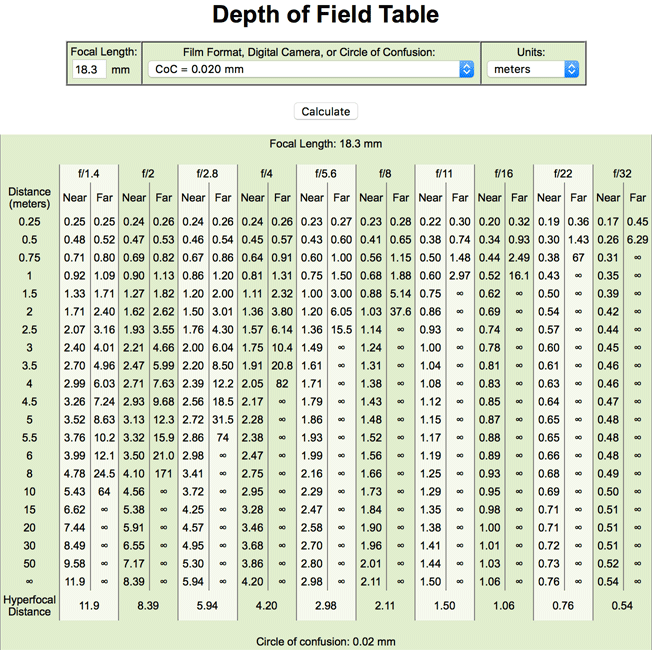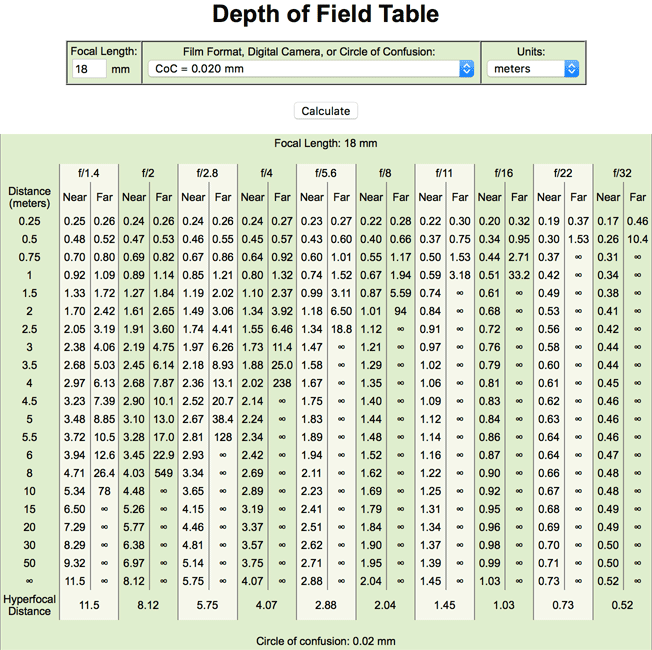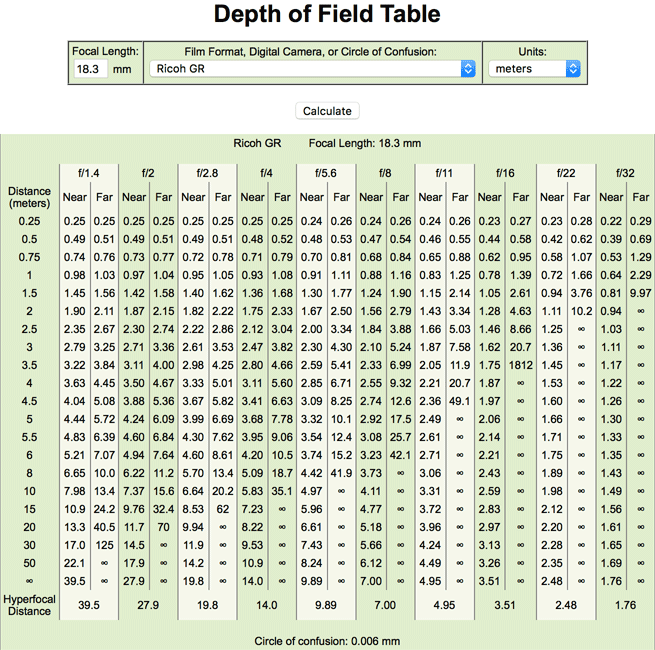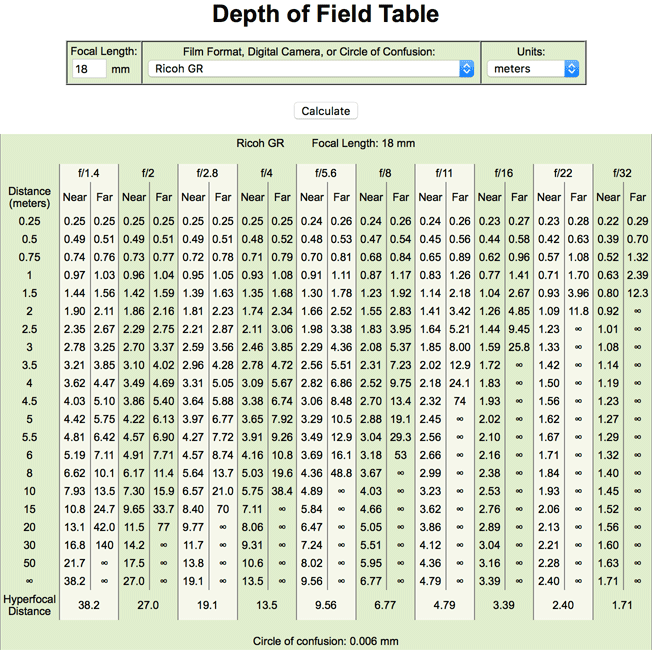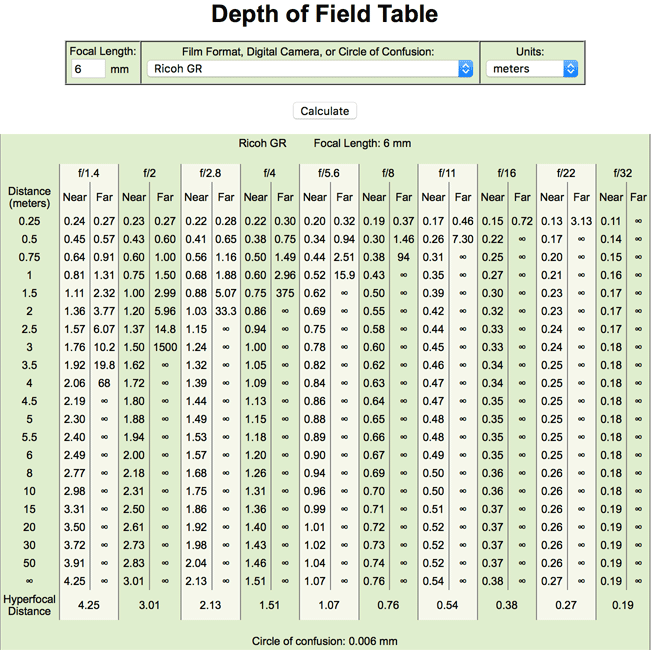Ricoh GR: Depth of Field Tables
Introduction | Calculations | Tables | Conclusions | References | Appendix
Archive
On this page, I present depth of field tables that I calculated using Excel for the Ricoh GR. The table calculations are based on formulae that I found on the DOFMaster Website and described on page Calculating Hyperfocal Distance and Depth of Field.
See the "disclaimer" regarding the validity of depth of field and hyperfocal distance calculations as well as of the circle of confusion, on which these calculations are based.
Tables
In the following, I present the results of my calculations of the depth of field for the Ricoh GR in various tabular formats. The tables show the depth of field near and far limits based on a circle of confusion of 0.02 mm and on one-third f-numbers. They appear in a window of their own, because I exported them from Excel in order to simplify my life.
Since there are three parameters that can be varied, namely focal length, distance, and aperture, a DOF table calculation would actually create a "data cube". In order to arrive at two-dimensional tables, one of the parameters has to be fixed during a calculation, and a separate table calculated for each of its values. I calculated tables for fixed focal length and for set distance.
For the conventions that I used in the tables, bee below. Note that I also include tables that were calculated using DOFMaster.
At the moment, I am still looking for a suitable graphical representation that mimics depth of field indicators on zoom lenses...
Table for one Focal Length - Transposed Table
Since the Ricoh has an equivalent focal length of 28 mm, I calculated a DOF table for this focal length (actually for the "correct" value of 18.3 mm). Transposing the table made it easier for me to manually compose tables for distances and to experiment with graphical representations.
- This page shows the corresponding table table with apertures in rows and near/far limits in columns.
- The transposed table shows the DOF values by distance (plus near/far limits) and corresponds in principle to the respective DOFMaster tables.
Conventions Used in the Tables
Infinity values appeared in the calculations as negative numbers. I replaced these with the text "inf" and marked the respective cells with a dark gray background. Since I dod not know, which distance can practically regarded as "infinity" for the Ricoh GR (and for a CoC of 0.02 mm), I arbitrarily decided that infinity starts at about 35 m. I would mark cells with distances beyond 35 m also with a dark gray background, which it is a little bit lighter than that of the "inf" cells, but there are no such cells in these tables.
DOFMaster Table
In addition to my own calculations, I used DOFMaster to calculated depth of field values for a focal length of 18.3 mm (28 mm equiv.) using a circle of confusion (choc) of 0.02 mm* (according to the APS-C sensor format) :
Notes
- *) Warning: If you select "Ricoh GR" in the field "Film Format, Digital Camera, or Circle of Confusion" you will get the table for the older digital GR with a 1/1.7" sensor and thus, a CoC of 0.006 mm, which leads to a completely different table (see below).
- DOFMaster lists f-numbers outside of the Ricoh GR's range. Nevertheless, these tables my be easier to read than mine, and they can also be used to validate my calculations.
- Initially, I calculated the DOFMaster table for a focal length of 18 mm; I found out that I can enter fractions of mm and re-calculated the table for 18.3 mm.
- DOFMaster uses a focal length of 18 mm in the calculations. I use a value of 18.3 mm as given by Ricoh. Therefore, the tables differ slightly (my values are stricter because of the slightly longer focal length).
In the appendix below, I present tables calculated for the newer APS-C GR and for the older small-sensor GRD (wrong ones and correct ones...); I also calculated tables for a focal length of 18.3 mm and 18 mm (and of 6 mm for the original GRD).
Conclusions
Probably, it is a much better idea to buy a calculator for the DOF than using my tables. But perhaps they can make one or the other suggestion as to how to set distance manually on the Ricoh GR.
References
Appendix
Ricoh GR (APS-C) with CoC = 0.020 mm and Focal Length of 18.3 mm
This is the table that should be compared with my own calculations.
Ricoh GR (APS-C) with CoC = 0.020 mm and Approximated Focal Length of 18 mm
This table differs slightly from my own calculations because of the approximated focal length.
Ricoh GR (1/1.7" sensor) with CoC = 0.006 mm and Focal Length of 18.3 mm
Note: You get the following table if you do not realize that you selected the wrong camera, namely the small-sensor GR. Because of the small CoC of 0.006 mm you get very shallow DOF values.
Note: This is a wrong table for the original digital GR (GRD).
Ricoh GR (1/1.7" sensor) with CoC = 0.006 mm and Approximated Focal Length of 18 mm
Note: You get the following table if you do not realize that you selected the wrong camera, namely the small-sensor GR. . Because of the small CoC of 0.006 mm you get very shallow DOF values.
Note: This is a wrong table for the original digital GR (GRD).
Ricoh GR (1/1.7" sensor) with CoC = 0.006 mm and Focal Length of 6 mm
This is a table for the original digital GR (GRD). It is based on a focal length of 6 mm as used by the GRD IV; older models may have slightly different focal lengths.
This is a table for the original digital GR (GRD).
| 03.04.2019 |
